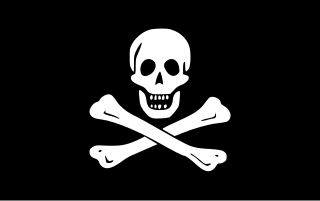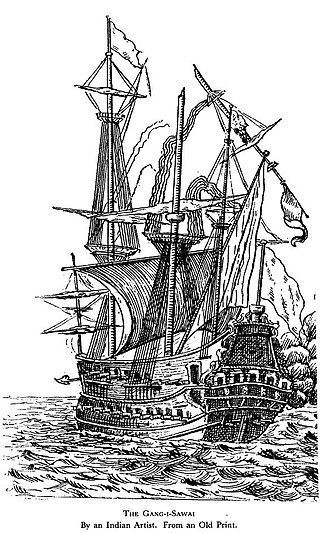See also 1699 in piracy, 1701 in piracy, and Timeline of piracy.
See also 1699 in piracy, 1701 in piracy, and Timeline of piracy.

Piracy is an act of robbery or criminal violence by ship or boat-borne attackers upon another ship or a coastal area, typically with the goal of stealing cargo and other valuable goods. Those who conduct acts of piracy are called pirates, and vessels used for piracy are called pirate ships. The earliest documented instances of piracy were in the 14th century BC, when the Sea Peoples, a group of ocean raiders, attacked the ships of the Aegean and Mediterranean civilisations. Narrow channels which funnel shipping into predictable routes have long created opportunities for piracy, as well as for privateering and commerce raiding.

Condent, born in Plymouth in Devon, was an English pirate who was best known for his piracies in the Indian Ocean.
Benjamin Hornigold (1680–1719) was an English pirate who operated during the tail end of the Golden Age of Piracy.

Thomas Tew, also known as the Rhode Island Pirate, was a 17th-century English privateer-turned-pirate. He embarked on two major pirate voyages and met a bloody death on the second, and he pioneered the route which became known as the Pirate Round. Other infamous pirates in his path included Henry Avery and William Kidd.

Benito de Soto Aboal was a Spanish pirate who operated in the Atlantic during the early 19th century. He was the captain of the pirate ship Defensor de Pedro, sometimes incorrectly named as the Burla Negra, that was responsible for several piracies in the Atlantic in 1828, in a period of increased piracy following the independence of the new states of South America.

Edward England was an Irish pirate. The ships he sailed on included the Pearl and later the Fancy, for which England exchanged the Pearl in 1720. His flag was the classic Jolly Roger — almost exactly as the one "Black Sam" Bellamy used — with a human skull above two crossed bones on a black background. Like Bellamy, England was known for his kindness and compassion as a leader, unlike many other pirates of the time.

The Golden Age of Piracy is a common designation for the period between the 1650s and the 1730s, when maritime piracy was a significant factor in the histories of the North Atlantic and Indian Oceans.

James Gilliam, or James Kelly was an English pirate and buccaneer active off the coasts of Spanish South and Central America and later in the Indian Ocean. He sailed under several different pirate captains but is best remembered for his brief association with William Kidd.
The Pirate Round was a sailing route followed by certain, mainly English, pirates, during the late 17th century and early 18th century. The course led from the western Atlantic, parallel to the Cape Route around the southern tip of Africa, stopping at Madagascar, then on to targets such as the coast of Yemen and India. The Pirate Round was briefly used again during the early 1720s. Pirates who followed the route are sometimes referred to as Roundsmen. The Pirate Round was largely co-extensive with the routes of the East India Company ships, of Britain and other nations.

John Bowen was a pirate of Créole origin active during the Golden Age of Piracy. He sailed with other famous contemporaries, including Nathaniel North and George Booth, who was his captain when he was a crewman aboard the Speaker. Over a four-year period, Bowen took about £170,000 in goods and coinage and retired to Bourbon for a brief period of time before his death in 1704.
See also 1698 in piracy, 1700 in piracy, and Timeline of piracy.
See also 1701 in piracy, other events in 1702, 1703 in piracy, and Timeline of piracy.
See also 1702 in piracy, other events in 1703, 1704 in piracy, and Timeline of piracy.
See also 1719 in piracy, 1721 in piracy and Timeline of piracy.

Thomas Howard was a pirate primarily active in the Indian Ocean and the Red Sea during the Golden Age of Piracy. He served under other pirates of the time, including George Booth and John Bowen. He also commanded the 36-gun Prosperous. He later retired to Rajapur, in India, where he married a local woman. He was later murdered by her relatives.

The Ganj-i-Sawai was an armed Ghanjah dhow belonging to the Mughals. During Aurangzeb's reign, it was captured on 7 September 1695 by the English pirate Henry Every en route from present-day Mocha, Yemen to Surat, India. It was built on the order of Empress Mariam-uz-Zamani, great grandmother of Aurengzeb, after the capture of her ship named Rahimi.
William Read was a pirate active in the Indian Ocean near Madagascar. He is best known for rescuing fellow pirate captains John Bowen and Thomas White.
John Cornelius was an Irish pirate allegedly active in the Red Sea and off the west coast of Africa. He succeeded William Lewis, who was killed after announcing he had made a deal with the Devil. Lewis and Cornelius are likely the fictional creations of Captain Charles Johnson, who presented their stories among those of real historical pirates.
John Pro was a Dutch pirate best known for leading a pirate trading post near Madagascar.
International piracy law is international law that is meant to protect against piracy. Throughout history and legal precedents, pirates have been defined as hostis humani generis, Latin for "the enemy of all mankind". The United Nations has codified much of the law in the United Nations Convention on the Law of the Sea (UNCLOS), which defines different types of piracy and ways to combat it.